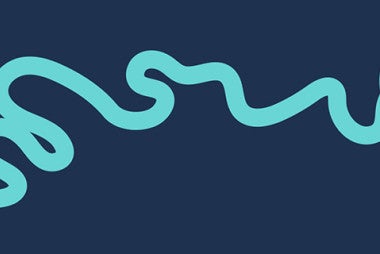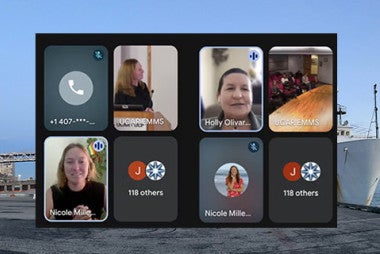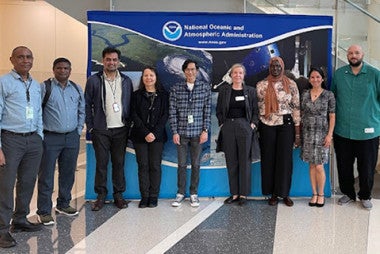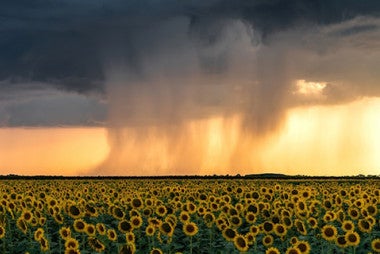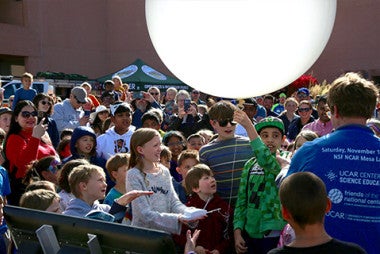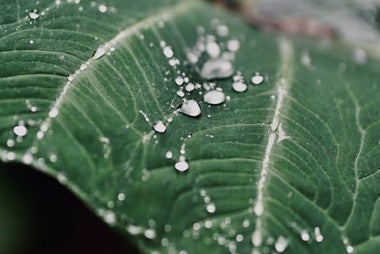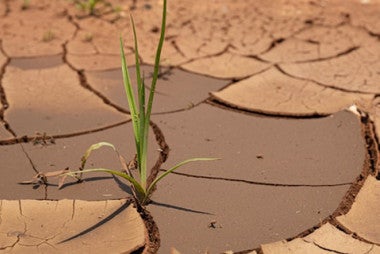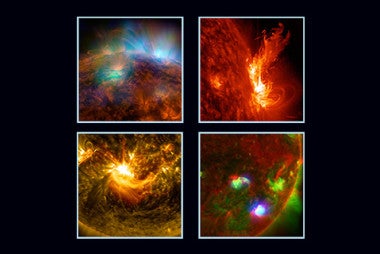Explorers-in-Training interns gain experience; contribute to NOAA mission
Since 2009, NOAA Ocean Exploration has partnered with UCAR Cooperative Programs for the Advancement of Earth System Science (CPAESS) to host more than 170 undergraduate and graduate students in the Explorers-in-Training (EiT) program.
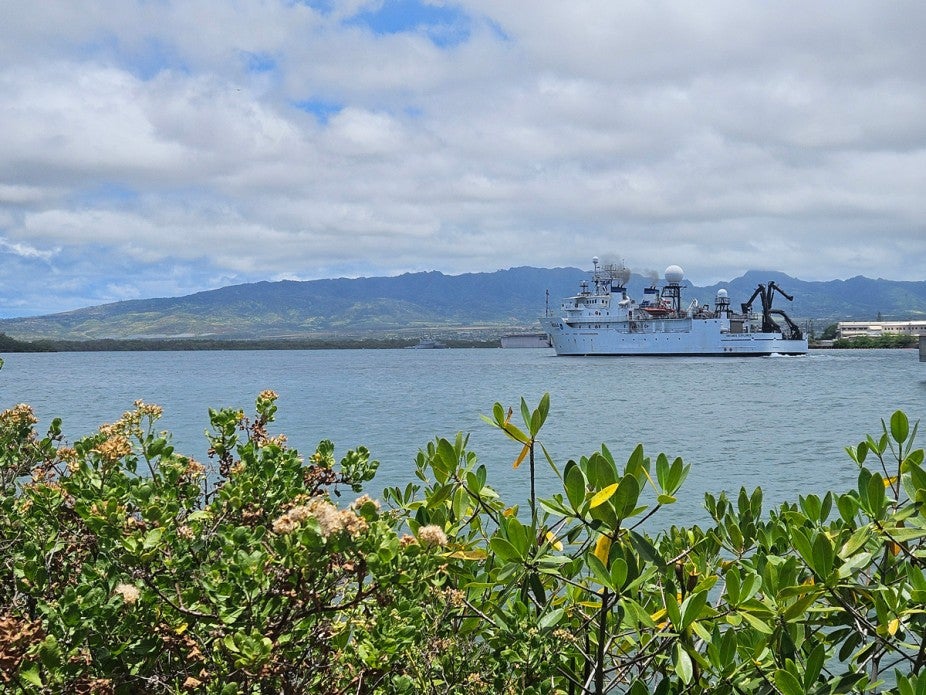
NOAA Ship Okeanos Explorer departs Oahu’s Ford Island, marking the start of the Beyond the Blue: Papahānaumokuākea Mapping 1 expedition in June 2024.
Credit: Jenny Crawford, NOAA.
This competitive program provides experiential learning opportunities to students through paid internships, equipping them with the knowledge and skills to meet the demands of the ocean exploration workforce while supporting NOAA Ocean Exploration’s mission of exploring the unknown ocean, enabling scientific discovery, technological advancements, and data delivery.
In 2024, nearly 1000 students applied for 16 spots in the EiT program, up from 430 in 2023 – a marker of the program’s success.
“The Explorer-in-Training program is a vital part of NOAA Ocean Exploration’s mission to train the next generation of ocean explorers, scientists, and communicators. Not only do interns make invaluable contributions to NOAA, each year we see students transform through hands-on experiences, collaborative projects, and meaningful mentorship,” said Jesse Gwinn, Internship Program Coordinator with UCAR CPAESS in support of NOAA Ocean Exploration.
In 2024, the program offered two types of opportunities. The first, a 2- to 4-week, expedition-based internship involved participation in NOAA Ocean Exploration expeditions such as contributing to seafloor mapping efforts on NOAA Ship Okeanos Explorer or improving science communication by developing web and social media content on ocean exploration topics. The 10-week internship provided students an opportunity to participate in longer-term projects led by NOAA Ocean Exploration mentors like using existing and new technologies to increase understanding of deepwater areas and better target future research.
Letting students speak for themselves, the following excerpts are from selected final reports on seafloor mapping and science communication projects and represent their creative approaches to helping solve real world problems in science.
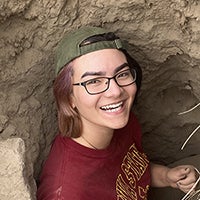 Elizabeth Huang
Elizabeth Huang
Whitman College, Walla Walla, WA
Mapping Explorer-in-Training
My Role: I was an Explorer-in-Training aboard NOAA Ship Okeanos Explorer as part of the Beyond the Blue: Papahānaumokuākea Mapping 1 expedition. We set sail from Joint Base Pearl Harbor-Hickam on June 21, 2024 and returned on July 9, 2024. The primary objective of the cruise was to increase mapping coverage in Papahānaumokuākea Marine National Monument. My main role was to monitor, collect, and clean the bathymetric data in real time.
Internship Outcomes: My work resulted in high resolution bathymetric data of previously unexplored waters in Papahānaumokuākea Marine National Monument. It will contribute to the broader goal of mapping the entire ocean floor in high resolution and will be available to the public as well as to scientists and future expedition coordinators.
Future Plans: I am going into my final year as an undergraduate and plan to attend graduate school for something geology-related. I want to make sure that what I study in graduate school is applicable to ocean expeditions, even if the program is not ocean-specific. I will never forget what it felt like to be part of a team out in the middle of the Pacific Ocean trying to make sense of what we were surrounded by, and I will carry that sense of awe and wonder with me wherever my career may go.
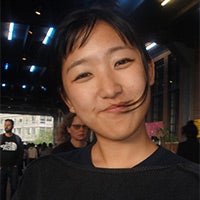 Lia Kim
Lia Kim
Barnard College, Columbia University
Science Communication Explorer-in-Training
My Role: The goal of this science communication internship with NOAA Ocean Exploration was to effectively communicate the intricacies of deep-ocean mapping aboard NOAA Ship Okeanos Explorer during the Beyond the Blue: Papahānaumokuākea Mapping 1 expedition. I wanted to accurately portray life at sea aboard Okeanos Explorer and during this historic expedition––this included writing about the science, the Hawaiian cultural protocols, and the details of daily boat life.
Internship Outcomes: By the end of my internship, I created and collaborated on three unique pieces:
- “What is bathymetry?” ocean fact: A short essay to explain a topic on ocean exploration in a way that it can be understood by a broad audience.
- “Lia Kim’s Reflection Logs Aboard NOAA Ship Okeanos Explorer”:
Cultural liaisons on the ship shared the significance of Papahānaumokuākea Marine National Monument in Hawaiian culture and history. With my background in anthropology, I wanted to create reflection logs that mirrored ethnographic field notes by including the cultural aspects of the mission.
- “Hawaiian Word of the Day”: While on the ship, I collaborated… to create social media content for NOAA Ocean Exploration [on Hawaiian words connected to ocean exploration].
Future Plans: Inspired by NOAA Ocean Exploration’s commitment to public knowledge, writing mindfully played an important role during this science communication internship. I have always been passionate about inclusive writing, especially within the sciences, so writing about science for the general public was extremely fun for me this summer. I enjoyed incorporating a specific style of writing into my pieces. I thought very hard about how I was communicating a certain science, technology, or cultural event aboard the ship. I feel even more excited about pursuing environmental journalism or science writing as a career. I am eager to work during this age of changing the practice of inaccessible science writing.
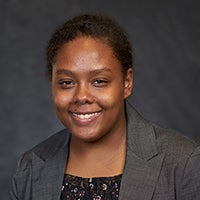 Cidney McMahon
Cidney McMahon
Syracuse University, Syracuse, NY
Mapping Explorer-in-Training
My Role: As an Explorer-in-Training intern, I had the opportunity to work on collecting seafloor data in the Papahānaumokuākea monument marine national monument. My role was to learn new software and assist with both hourly and daily data collection tasks aboard the NOAA Okeanos Explorer. Our objective was to collect new data and produce images of previously unexplored seafloor.
Internship Outcomes: [Software that provided 2D and 3D] visuals of the seafloor allowed us to view detailed features of the seafloor and edit unwanted data produced by the data collection machinery. We completed collecting several lines of data and produced a large image of what the seafloor is predicted to look like. The image we collected was roughly the size of Montana or Japan with more than 37,000 km2 of unmapped sea floor collected. The data produced by NOAA is released to the public … and is also often used by different academics and institutions for research purposes… We ultimately accomplished our objective of collecting new data and a large accurate image of the seafloor [and did so] with the intention of being respectful and aware of the cultural significance of the seas we were exploring and incorporated Hawaiian cultural traditions, such as a traditional sunrise and sunset ceremony, into our everyday life at sea.
Future Plans: Being at sea is both rewarding and challenging at times. From learning how to work efficiently and effectively on a moving vehicle to living and corresponding with a ship crew, this internship has given me an invaluable experience that I will carry with me throughout my career. I hope to conduct future research related to oceanography and seafloor mapping in the future and am looking for opportunities related to my internship and research interest in my senior year.
While each student aims to embark on a unique career path in an ocean- or science-related field, all of them share a passion for and commitment to the importance of the ocean in our everyday lives.
“The growth and success of the program are a testament to its impact and critical role in shaping the future of ocean exploration,” said Gwinn.
For more on outreach programs related to mapping the ocean floor, see the related story, Art meets science at the Mokupāpapa Discovery Center in Hilo, Hawaiʻi.
